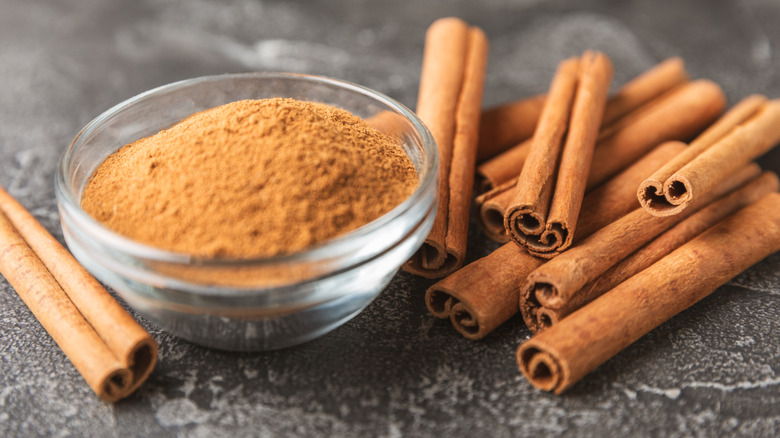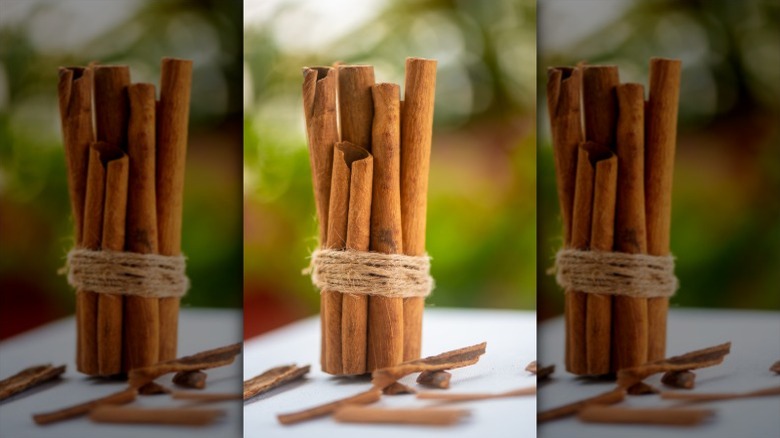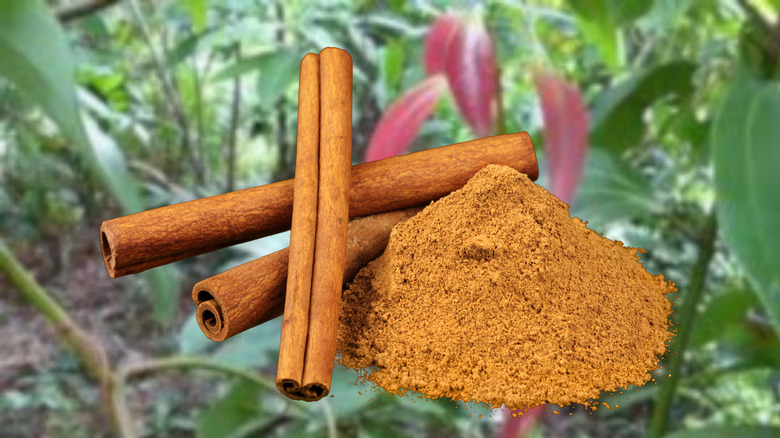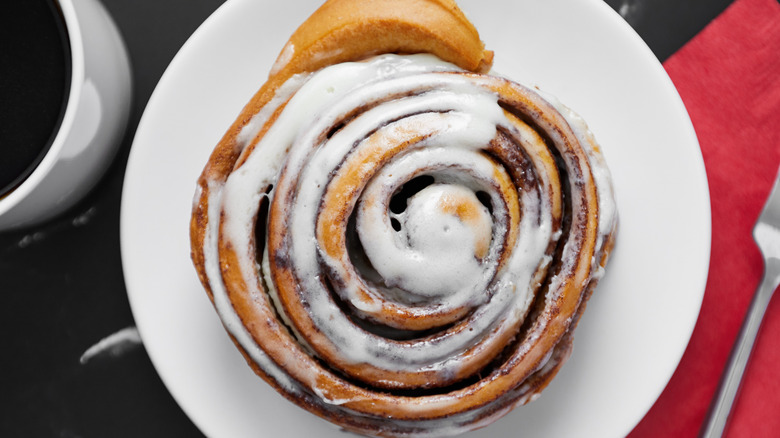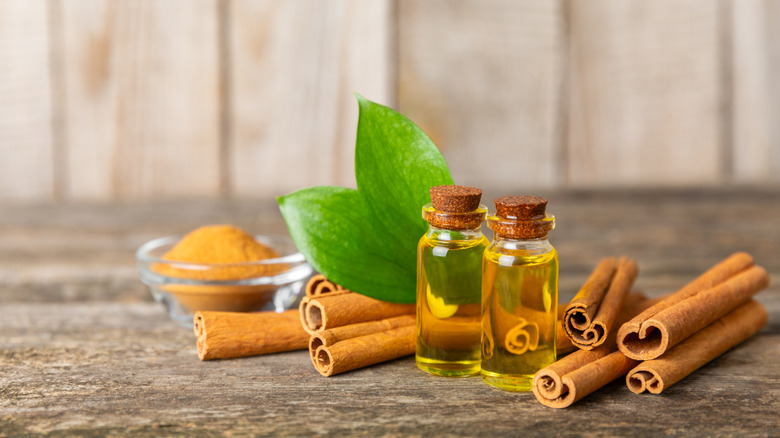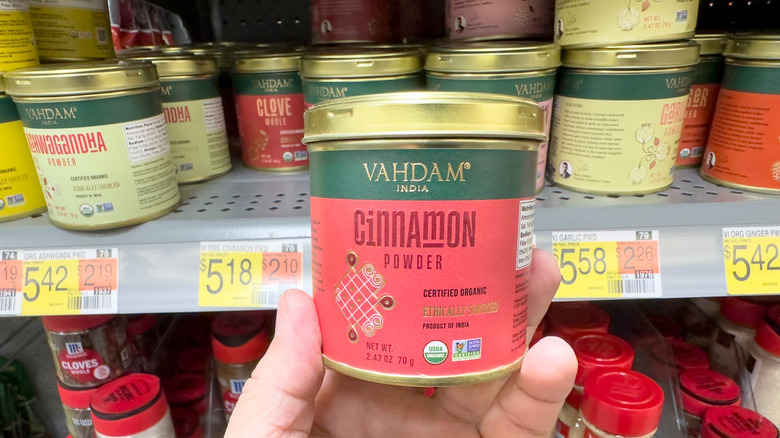5 Ways To Spot Fake Cinnamon
Before we get into any kind of discussion about what constitutes "fake" cinnamon, let's clarify that there is more than one variety of this spice. Cinnamon is made by drying the bark of the Cinnamomum tree, but there are various trees in the family, and none of them have an exclusive right to call themselves cinnamon. This is to say that, unless you've purchased ingredients from a shady supplier that cuts its spices with sawdust, you probably don't have "fake" cinnamon in the pantry, nor does there seem to be a thriving black market in counterfeit spices.
That being said, there are two main species of cinnamon, and some people feel that one is of higher quality than the other. This species, which is called Cinnamomum verum, is grown in Sri Lanka and is often sold under the name of Ceylon cinnamon. (The independent state of Sri Lanka dropped the colonial name of Ceylon beginning in 1972.) While some consider Cinnamomum verum to be "true" cinnamon, as referenced in the name — verum being Latin for "truth" — chances are, most of us are even more familiar with a different variety called Cinnamomum aromaticum or Cassia cinnamon. The trees from which it is obtained grow throughout Southeast Asia, while the spice produced from its bark is more readily available in the U.S.
The sticks look and feel different
What does a cinnamon stick look like? They are brown in color, and resemble, well, strips of curled tree bark, since that is exactly what they are. If you should happen to have both types of cinnamon sticks on hand, though, a side-by-side comparison of Ceylon vs, cassia should yield a few differences in appearance. For starters, Ceylon cinnamon sticks may be quite a bit lighter in color, more of a tan than the rich, reddish-brown hue we associate with cinnamon. They also consist of thinner sheets rather than the wider rolls we're accustomed to.
The reason for this difference, besides the fact that the two cinnamons come from different species of tree, is that they may also be processed differently. Cassia cinnamon bark is aged for 20 years before being stripped off in 1/16-inch layers, cleaned, and dried. Ceylon cinnamon bark, however, is first softened in water, then the outer bark is removed, and the inner, thinner bark is peeled, dried, and rolled into sticks.
It could taste different, too
One of the components that give both varieties of cinnamon their distinctive flavor is a compound called cinnamaldehyde. This flavoring agent, which is found in the bark of both Cinnamomum verum and Cinnamomum aromaticum trees, varies in degree of concentration. Ceylon cinnamon may contain as little as 50% cinnamaldehyde, whereas cassia cinnamon oil is approximately 95% cinnamaldehyde.
It practically goes without saying, in light of this information, that cassia cinnamon has a much stronger, more robust flavor than Ceylon cinnamon. In fact, if you're on the fence about cinnamon as a spice in general and find it too overpowering, you may actually prefer the "cinnamon light" flavor of Ceylon. It's not only milder, but also has a bit more sweetness to it, and it can also be described as somewhat floral in nature. (Botanical at any rate, although that is the same with cassia cinnamon since both products come from trees.) On the other hand, however, if you're used to full-bodied cassia cinnamon flavor, you may find Ceylon cinnamon's delicateness to be somewhat of a disappointment.
Some recipes may be better with one or the other
Should you be so fortunate as to have two types of cinnamon on hand, then you'll be able to pick and choose which type is best suited to which recipe. Part of this will come from personal preference, since if you prefer a subtler cinnamon flavor, Ceylon may be just the ticket. If you're a cinnamon superfan who wants that big, bold flavor, though, you may be better off sticking with cassia.
If you're still on the fence, we do have a few suggestions based on some of our own cinnamon-laced recipes. Cassia would be our top pick for a cinnamon-forward dish like brown butter cinnamon rolls (after all, the flavor is right there in the name!), and we'd also want it for our wake and bake French toast casserole. Things could go either way with our Swedish apple pie, however, depending on whether you want a really robust cinnamon flavor or prefer a more apple-forward pie. Where we'd definitely opt for Ceylon cinnamon, however, would be in recipes like blueberry babka and chipotle orange piloncillo cookies, where flavors other than cinnamon deserve a chance to shine. It would also be a better choice for cinnamon sugar popcorn since it would lend the snack just a hint of sweet spice.
Too much Cassia cinnamon might make you sick
Both types of cinnamon, Ceylon and cassia, are reputed to have health benefits, and there may well be some evidence to back this up. Of the two varieties, more research studies seem to have focused on cassia, and it does seem to have an effect on reducing elevated blood sugar levels. Both varieties may also help prevent the buildup of a brain protein that may be linked to the development of Alzheimer's, while Ceylon cinnamon in the form of a nasal spray is being tested for hay fever. It's important to note, however, that many of these purported health benefits are still at the speculative stage. There's also some possibility of danger if excessive amounts of cinnamon are consumed, particularly the cassia variety.
The issue with cassia cinnamon is something that shouldn't arise if it's being consumed in the typical amounts used in recipes. If taken as a supplement for an extended period of time, though, it might possibly harm the liver. The reason for this is that cassia cinnamon contains much higher amounts of coumarin than Ceylon cinnamon, and large doses of coumarin may damage the kidneys and lungs as well as the liver. For this reason, it's advisable to limit the consumption of cassia cinnamon — particularly the coumarin-rich Saigon kind — to under one teaspoon per day.
Cassia cinnamon could cost a lot less
Perhaps the most striking difference you'll see between Ceylon and cassia cinnamon, which will be readily apparent before you get either one out of its packaging, is their respective price tags. The reason why Ceylon cinnamon is the more expensive of the two has to do with its more labor-intensive manufacturing process as well as the fact that it's simply in shorter supply. There's also a certain amount of snob appeal linked to this more "exclusive" product, and this never hurts when it comes to bumping up prices.
So what does this look like in terms of dollars and cents? Your cinnamon shopping experience will likely vary depending on where the store purchases its supplies, but as a "fr'instance," Amazon is currently selling a 2.08-ounce jar of Simply Organic ground Ceylon cinnamon for $5.89 or $2.83 per ounce. In contrast, that same retailer sells an 18-ounce jar of McCormick ground cinnamon for $15.47, which amounts to $0.86 per ounce. If you use a lot of cinnamon, that's quite the price difference, since this standard cassia cinnamon costs less than one-third of the Ceylon kind. As to whether the upcharge is worth it, that's something that only you can say.
